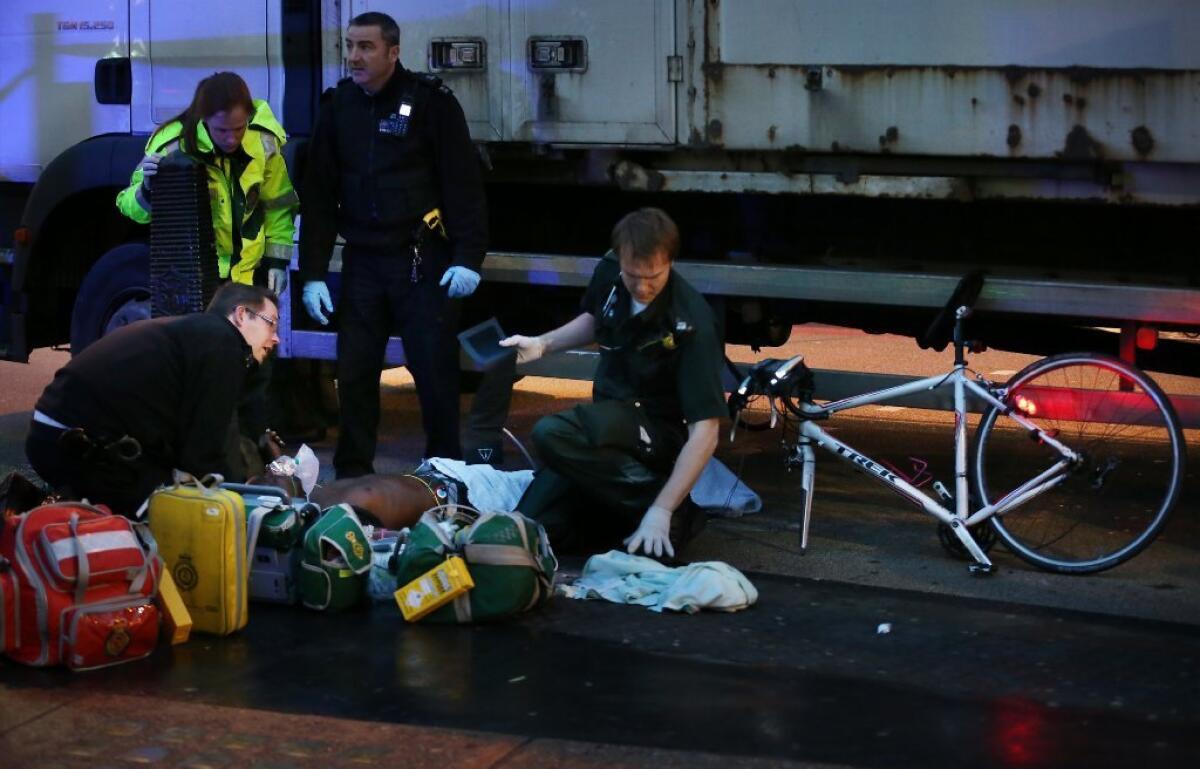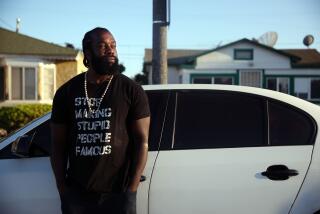London cycling deaths spark an important debate. L.A. should tune in.

- Share via
London is not a bicycle haven like Copenhagen or Amsterdam. But it has gone for cycling in a big way, especially since electing cycling advocate Boris Johnson mayor in 2008. Now the city is reeling over the death of six cyclists in the last two weeks (and 14 this year), and the public debate over the issue in the British media and online bears some resemblance to the arguments heard in California as urban cycling becomes more common: Are trucks the primary culprit? To what degree should cyclists bear any blame? Should bicycle routes be physically separated from cars?
Johnson is considering banning cyclists from wearing headphones. As reported in the Guardian, he called headphones an “absolute scourge” and said cyclists were “absolutely nuts” to wear them. Others (as noted in the Standard) want to take a cue from Paris and keep trucks out of central London during rush hours.
But physically separated bike lanes may be the most controversial suggestion, and not merely because there is some expense in constructing them or even because they often mean the elimination of some car lanes.
FULL COVERAGE: Sharing the road in L.A.
The (usually) concrete barriers that separate bike lanes from car traffic are also an ideological divide among cyclists. Should riders be considered “vehicular” traffic, riding among motor vehicles, without special bike-only lines? That arguably implies a higher level of responsibility that riders must bear for their own safety. Or should they be protected by separated lanes or at least bike-only lanes, or at the very least by “sharrows” — the symbols painted on streets that tell cyclists they have a right to be there and remind drivers they are sharing the road with bikes?
I recall being shocked some 40 years ago when the leaders of a bike group told an organization I belonged to — it must have been the Boy Scouts — that they opposed bike lanes. School kids, including me, had been rallying to get Los Angeles to paint more stripes on city streets to encourage more of us to ride to the library, to school and elsewhere, and not be so reliant on driving parents and older siblings. Surely all cyclists would agree.
But the group — if I recall correctly, it was L.A. Wheelmen — argued that cyclists co-owned the roads, that they must deal with the dangers of riding with cars, and that they shouldn’t rely on the false sense of security offered by painted lines on the road. Cars could still swerve into them; cyclists still had to pay attention at all times.
That’s true of the special bike-only green lanes in Los Angeles; they are open to cars making right-hand turns, so the green lane remains shared space. NPR reported that several of the recent London bike deaths happened in analogous blue lanes.
But cyclist deaths in bike lanes are at least as good an argument for separated lanes as for more or better bike lanes. At last week’s California by Bike Summit, many advocates for more cycling on urban streets noted that they have already picked the “low-hanging fruit” — commuters and others who are willing to get on their bikes and share busy streets with cars. To expand, the argument goes, would-be cyclists need the greater sense of safety that separated lanes would give them. Long Beach has rolled out some such lanes, as has New York.
And that’s great — if there is a protected lane that goes directly from the commuting cyclist’s home to the office, and especially in heavily trafficked areas like central London.
For other trips in other places — well, we’re not likely to ever have separated lanes everywhere. London’s emergency measure makes some sense: A little more enforcement against law-breaking drivers — OK, fine, and maybe even headphone-wearing cyclists — can only help.
ALSO:
Should cyclists yield at stop signs?
Killed or injured cyclists had it coming? Get a grip, motorists.
Fear and loathing and cycling in L.A.: Tales of a bike commuter
This post is part of an ongoing conversation to explore how the city’s cyclists, drivers and pedestrians share and compete for road space, and to consider policy choices that keep people safe and traffic flowing. For more: latimes.com/roadshare and #roadshareLA.
More to Read
A cure for the common opinion
Get thought-provoking perspectives with our weekly newsletter.
You may occasionally receive promotional content from the Los Angeles Times.











